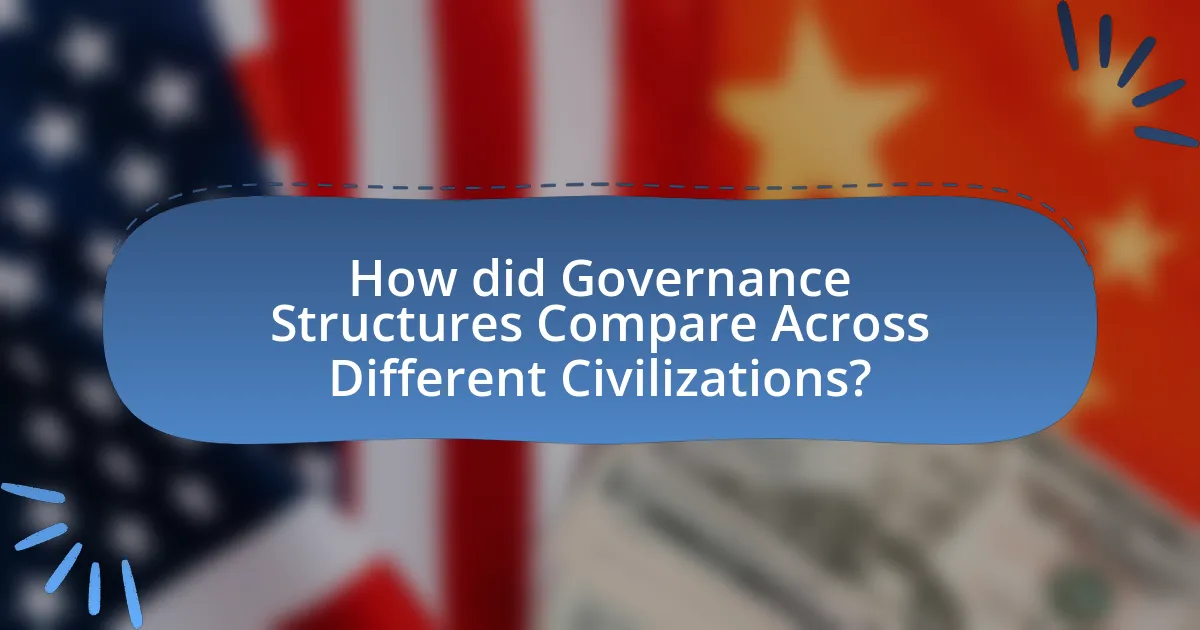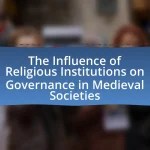Governance structures in Pre-Columbian civilizations, including the Aztec, Inca, and Maya, exhibited significant variations characterized by centralized authority, hierarchical organization, and complex political systems. The article explores the evolution of these governance structures from tribal systems to more organized bureaucracies, influenced by environmental conditions, social organization, and cultural beliefs. It examines the roles of leaders, the establishment and enforcement of laws, and the impact of geography on governance. Additionally, the article compares governance systems across different civilizations, highlighting similarities and unique aspects, while also discussing the implications of these structures on social organization, economic development, and cultural practices. Insights from these historical governance models are presented as valuable lessons for contemporary governance practices.

What are Governance Structures in Pre-Columbian Civilizations?
Governance structures in Pre-Columbian civilizations varied significantly across different cultures, often characterized by centralized authority, hierarchical organization, and complex political systems. For instance, the Aztec Empire operated under a theocratic monarchy where the emperor held supreme power, supported by a council of nobles and priests, which facilitated governance over a vast territory. Similarly, the Inca Empire employed a highly organized bureaucracy, with the Sapa Inca at the top, overseeing a network of provincial governors who managed local affairs, ensuring efficient administration and resource distribution. These governance structures were essential for maintaining order, managing resources, and facilitating trade within these advanced societies.
How did governance evolve in these civilizations?
Governance in Pre-Columbian civilizations evolved from tribal and clan-based systems to more centralized and complex political structures. For instance, the Maya developed city-states with hierarchical governance, where rulers held both political and religious authority, as evidenced by the existence of monumental architecture and codices detailing governance practices. Similarly, the Inca established a vast empire with a centralized bureaucracy, utilizing a system of roads and messengers to maintain control over diverse regions, which is supported by archaeological findings of administrative centers and extensive record-keeping. These developments reflect a transition towards organized governance that facilitated resource management, social order, and territorial expansion.
What factors influenced the development of governance structures?
The development of governance structures in pre-Columbian civilizations was influenced by factors such as environmental conditions, social organization, economic systems, and cultural beliefs. Environmental conditions, including geography and climate, dictated resource availability and settlement patterns, which in turn shaped political organization. For example, the agricultural surplus in the fertile regions of Mesoamerica allowed for more complex governance systems, as seen in the centralized authority of the Aztec Empire. Social organization, including kinship ties and class structures, also played a crucial role; hierarchical societies often developed more formal governance structures to manage resources and social order. Economic systems, particularly trade networks, necessitated governance to regulate exchanges and maintain stability. Cultural beliefs, including religious practices and ideologies, further influenced governance by legitimizing authority and shaping laws. These interconnected factors collectively contributed to the evolution of governance structures in various pre-Columbian civilizations.
How did geography impact governance in different regions?
Geography significantly influenced governance in different regions by shaping the political structures, resource management, and social organization of pre-Columbian civilizations. For instance, the Andes mountains facilitated the development of centralized governance in the Inca Empire, where the rugged terrain necessitated a strong, hierarchical authority to manage resources and infrastructure across diverse ecological zones. In contrast, the flat plains of Mesoamerica allowed for more decentralized governance structures, as seen in the city-states of the Maya civilization, where local rulers maintained autonomy while engaging in trade and alliances. Additionally, the availability of water sources and fertile land directly impacted agricultural practices, which in turn influenced the stability and complexity of governance systems, as evidenced by the agricultural surplus that supported larger populations and more intricate political organizations in regions like the Nile Valley.
What were the key characteristics of governance in Pre-Columbian societies?
The key characteristics of governance in Pre-Columbian societies included centralized authority, social stratification, and the integration of religion into political systems. Centralized authority was often embodied in a ruling elite or a single leader, such as the Inca emperor, who wielded significant power over resources and decision-making. Social stratification was evident in the division of society into classes, where nobles, priests, and commoners had distinct roles and privileges, as seen in the Aztec and Maya civilizations. Additionally, governance was closely tied to religious practices, with leaders often serving as both political and spiritual figures, reinforcing their authority through divine legitimacy, as exemplified by the role of priests in the governance of the Maya city-states.
What roles did leaders play in these governance structures?
Leaders in pre-Columbian governance structures served as central figures in decision-making, resource allocation, and social organization. They often held authority derived from religious, military, or hereditary power, which enabled them to maintain order and enforce laws within their communities. For instance, in the Inca Empire, the Sapa Inca was considered a divine ruler, responsible for both governance and religious practices, which reinforced his authority and the social hierarchy. Similarly, among the Maya, leaders known as “Ajaw” acted as political and spiritual leaders, guiding their city-states through diplomacy and warfare, thus shaping the political landscape of the region. These roles were crucial for the stability and cohesion of their respective societies, as leaders facilitated trade, managed agricultural production, and organized labor for large-scale projects, such as temples and roads, which were vital for the civilization’s infrastructure and cultural identity.
How were laws and regulations established and enforced?
Laws and regulations in pre-Columbian civilizations were established through a combination of customary practices, religious edicts, and codified statutes. For instance, the Maya civilization developed a complex legal system that included written laws inscribed on stelae, which were publicly displayed to inform the populace. Enforcement was typically carried out by local leaders or appointed officials who had the authority to adjudicate disputes and impose penalties, often supported by the community’s social norms and religious beliefs that emphasized adherence to these laws. The Inca Empire also exemplified this, as they implemented a centralized legal framework enforced by a network of officials known as “curacas,” who ensured compliance across their vast territory.
What types of governance systems existed among Pre-Columbian civilizations?
Pre-Columbian civilizations exhibited various governance systems, including centralized monarchies, city-states, and confederacies. For instance, the Aztec Empire operated under a centralized monarchy led by an emperor, who wielded significant power over military, religious, and administrative functions. In contrast, the Maya civilization was characterized by a network of city-states, each governed by its own ruler, often engaging in alliances and rivalries with one another. Additionally, the Inca Empire exemplified a highly centralized system with a bureaucratic structure that managed vast territories through a hierarchy of officials. These governance systems were integral to the social, economic, and political organization of their respective civilizations, influencing their development and interactions.
What are the differences between centralized and decentralized governance?
Centralized governance consolidates authority and decision-making power within a single central entity, while decentralized governance distributes power across multiple local entities or regions. In centralized systems, such as the Inca Empire, the emperor held supreme authority, enabling swift decision-making and uniform policies across vast territories. Conversely, decentralized governance, exemplified by the various city-states in Mesoamerica, allowed for local leaders to exercise autonomy, fostering diverse practices and adaptations to regional needs. This structural difference impacts resource allocation, administrative efficiency, and the responsiveness of governance to local populations.
How did kinship and lineage influence governance?
Kinship and lineage significantly influenced governance by establishing social hierarchies and political authority in pre-Columbian civilizations. In societies such as the Inca and Maya, rulers often derived their legitimacy from their ancestral lineage, which was believed to connect them to divine or heroic figures. This connection reinforced their authority and justified their governance, as seen in the Inca’s claim of descent from the sun god Inti, which legitimized their rule over vast territories. Additionally, kinship ties facilitated alliances and resource distribution, as leaders relied on familial networks to maintain power and control. The importance of lineage is evident in the hereditary succession of leadership roles, where positions were typically passed down within specific families, ensuring continuity and stability in governance structures.

How did Governance Structures Compare Across Different Civilizations?
Governance structures varied significantly across different civilizations, reflecting their unique cultural, social, and economic contexts. For instance, the centralized bureaucratic system of the Inca Empire, characterized by a strong central authority and extensive administrative networks, contrasted sharply with the more decentralized tribal governance seen among the North American Indigenous peoples, where local leaders held sway over smaller communities. Additionally, the city-states of Mesoamerica, such as the Maya, exhibited a mix of centralized and decentralized governance, with powerful kings ruling over city-states while local elites maintained influence. Historical records indicate that these differences in governance structures were influenced by factors such as geography, resource availability, and social organization, leading to diverse political systems that shaped the development of each civilization.
What similarities can be found in governance structures of various Pre-Columbian civilizations?
Various Pre-Columbian civilizations exhibited similarities in their governance structures, primarily characterized by centralized authority, hierarchical organization, and the integration of religious and political leadership. Centralized authority is evident in civilizations such as the Aztecs and Incas, where a single ruler or emperor held significant power over vast territories, often supported by a bureaucracy that managed local governance. Hierarchical organization is reflected in the social stratification seen in these societies, with nobles and priests occupying high-ranking positions that facilitated governance and resource distribution. Additionally, the intertwining of religious and political leadership is a common feature, as leaders often claimed divine right or were considered intermediaries between the gods and the people, reinforcing their authority and legitimacy. This integration is exemplified in the Inca Empire, where the Sapa Inca was viewed as a descendant of the sun god, thus merging governance with spiritual significance.
How did the Inca and Aztec governance systems compare?
The Inca and Aztec governance systems differed significantly in structure and function. The Inca Empire operated under a centralized system led by the Sapa Inca, who was considered a divine ruler with absolute authority, supported by a bureaucratic hierarchy that managed various aspects of governance across its vast territory. In contrast, the Aztec Empire utilized a more decentralized system, where power was shared among multiple city-states, each governed by its own leader, while the emperor held a more symbolic role, primarily serving as a military leader and religious figure.
The Inca’s governance was characterized by a highly organized administrative system that included a network of roads and messengers to facilitate communication and control, enabling efficient tax collection and resource distribution. The Aztec governance relied on tribute from conquered territories, which fostered a complex relationship between the central authority and local rulers, leading to a more fragmented political landscape.
These differences illustrate the Inca’s focus on centralized control and integration, while the Aztec system emphasized local autonomy within a broader imperial framework.
What common themes emerged in governance practices across these societies?
Common themes in governance practices across Pre-Columbian civilizations include centralized authority, social stratification, and religious integration. Centralized authority is evident in the hierarchical structures of empires like the Aztecs and Incas, where a single ruler held significant power over vast territories. Social stratification is reflected in the division of society into distinct classes, with nobility, priests, and commoners, influencing resource distribution and political influence. Religious integration is a theme where governance was closely tied to spiritual beliefs, as seen in the Mayan civilization, where rulers were often viewed as divine or semi-divine figures, legitimizing their authority through religious practices. These themes illustrate the complex interplay between power, society, and spirituality in shaping governance across these societies.
What were the unique aspects of governance in specific civilizations?
Unique aspects of governance in specific civilizations include the centralized authority of the Inca Empire, which utilized a system of bureaucratic administration to manage vast territories through a network of local leaders known as “ayllus.” This structure allowed for efficient resource distribution and social organization. In contrast, the Maya civilization exhibited a decentralized governance model, where city-states operated independently under their own rulers, often leading to competition and conflict among them. The Aztec Empire, on the other hand, combined elements of both centralization and local autonomy, with a powerful emperor overseeing a tribute system that integrated various conquered peoples while allowing them some degree of self-governance. These governance structures were shaped by each civilization’s unique social, economic, and environmental contexts, influencing their political stability and cultural development.
How did the governance of the Maya differ from that of the Mississippians?
The governance of the Maya was characterized by a decentralized system of city-states, each ruled by its own king, while the Mississippians operated under a more centralized authority with a chiefdom system. In the Maya civilization, individual city-states like Tikal and Calakmul had their own rulers and political structures, leading to a complex network of alliances and rivalries. In contrast, the Mississippian culture, exemplified by Cahokia, featured a hierarchical structure where a paramount chief held significant power over multiple communities, often supported by a council of elites. This distinction highlights the varied approaches to governance in these two pre-Columbian civilizations, reflecting their unique social, political, and economic contexts.
What innovations in governance were introduced by different cultures?
Different cultures introduced various innovations in governance, including centralized authority, legal codes, and administrative systems. For instance, the Aztecs developed a highly centralized government with a tribute system that required conquered territories to pay taxes, which facilitated resource distribution and control. Similarly, the Inca Empire implemented a complex administrative structure known as the “Mit’a” system, which organized labor and resources for state projects, ensuring efficient governance across vast territories. Additionally, the Maya civilization established a system of city-states governed by a council of nobles, which allowed for localized decision-making while maintaining overarching cultural unity. These innovations reflect the diverse approaches to governance that emerged in pre-Columbian civilizations, each tailored to their unique societal needs and challenges.

What Impact Did Governance Structures Have on Pre-Columbian Societies?
Governance structures significantly influenced the social, economic, and political dynamics of Pre-Columbian societies. For instance, the centralized governance of the Inca Empire facilitated efficient resource distribution and infrastructure development, which supported a vast population and integrated diverse cultures across the Andes. Similarly, the city-states of the Maya exhibited a decentralized governance model that fostered competition and innovation among various polities, leading to advancements in agriculture and astronomy. These governance frameworks shaped societal organization, influenced trade networks, and determined conflict resolution methods, ultimately impacting the longevity and stability of these civilizations.
How did governance influence social organization and hierarchy?
Governance significantly influenced social organization and hierarchy by establishing systems of authority and control within Pre-Columbian civilizations. For instance, centralized governance structures, such as those seen in the Aztec and Inca empires, created distinct social classes, including nobility, priests, and commoners, which were essential for maintaining order and resource distribution. The Aztec Empire’s tribute system exemplified this, as it required conquered peoples to provide goods and services, reinforcing the power of the ruling class and solidifying social stratification. Additionally, governance mechanisms, such as codified laws and administrative roles, facilitated the organization of labor and the allocation of resources, further entrenching hierarchical relationships within these societies.
What role did governance play in economic development?
Governance played a crucial role in economic development by establishing the frameworks and institutions necessary for resource allocation, trade regulation, and social order. Effective governance in pre-Columbian civilizations, such as the Inca and Maya, facilitated agricultural productivity through land management and irrigation systems, which directly supported economic growth. For instance, the Inca Empire implemented a centralized system that organized labor and resources, leading to the efficient production of crops and goods, which in turn enhanced trade networks. Additionally, governance structures provided stability and security, encouraging investment and innovation, as seen in the sophisticated marketplaces of the Maya civilization. These historical examples illustrate that governance directly influenced economic development by creating an environment conducive to growth and prosperity.
How did governance affect cultural practices and community cohesion?
Governance significantly influenced cultural practices and community cohesion in Pre-Columbian civilizations by establishing social norms and facilitating collective identity. For instance, centralized governance in the Inca Empire promoted the integration of diverse ethnic groups through shared religious practices and state-sponsored festivals, which reinforced social unity. Additionally, the Aztec governance system, characterized by tribute collection and public works, fostered a sense of belonging among citizens, as communal projects like temples and marketplaces became focal points for cultural expression and social interaction. These governance structures not only regulated daily life but also shaped the cultural landscape, ensuring that community cohesion was maintained through shared governance and cultural practices.
What lessons can be learned from the governance structures of Pre-Columbian civilizations?
The governance structures of Pre-Columbian civilizations demonstrate the importance of centralized authority, social stratification, and community involvement in decision-making. For instance, the Inca Empire utilized a highly organized bureaucracy that facilitated efficient resource distribution and infrastructure development, showcasing how centralized governance can enhance societal cohesion and economic stability. Additionally, the Maya civilization’s city-states exhibited a blend of religious and political leadership, indicating that integrating cultural values into governance can strengthen community identity and loyalty. These examples illustrate that effective governance can arise from a balance of authority, social hierarchy, and cultural integration, providing valuable insights for contemporary governance models.
How can modern societies apply insights from these historical governance systems?
Modern societies can apply insights from historical governance systems by adopting principles of decentralized decision-making and community involvement, as exemplified by the governance structures of Pre-Columbian civilizations like the Inca and the Maya. These civilizations utilized local councils and communal assemblies to ensure that diverse voices were heard, fostering a sense of ownership and accountability among citizens. For instance, the Inca Empire’s use of the “ayllu” system allowed for collective resource management and social cohesion, which can inform contemporary practices in participatory governance. By integrating similar frameworks, modern societies can enhance civic engagement and improve policy outcomes, as evidenced by studies showing that participatory governance leads to more equitable and sustainable development.
What best practices can be derived from the successes and failures of these governance structures?
Best practices derived from the successes and failures of governance structures in Pre-Columbian civilizations include the establishment of clear leadership roles, effective resource management, and adaptive governance strategies. Clear leadership roles, as seen in the Inca Empire, facilitated decision-making and unity, while effective resource management, exemplified by the agricultural practices of the Maya, ensured sustainability and food security. Adaptive governance strategies, demonstrated by the flexibility of the Aztec political system in response to changing circumstances, allowed for resilience in the face of challenges. These practices highlight the importance of structured leadership, resource optimization, and adaptability in governance.


